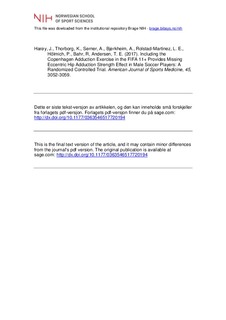| dc.contributor.author | Harøy, Joar | |
| dc.contributor.author | Thorborg, Kristian | |
| dc.contributor.author | Serner, Andreas | |
| dc.contributor.author | Bjørkheim, Andre | |
| dc.contributor.author | Rolstad-Martinez, Linn E. | |
| dc.contributor.author | Hölmich, Per | |
| dc.contributor.author | Bahr, Roald | |
| dc.contributor.author | Andersen, Thor Einar | |
| dc.date.accessioned | 2017-12-12T09:58:09Z | |
| dc.date.available | 2017-12-12T09:58:09Z | |
| dc.date.issued | 2017-08-14 | |
| dc.identifier.citation | American Journal of Sports Medicine. 2017, 45, 3052-3059 | nb_NO |
| dc.identifier.uri | http://hdl.handle.net/11250/2470607 | |
| dc.description | I Brage finner du siste tekst-versjon av artikkelen, og den kan inneholde ubetydelige forskjeller fra forlagets pdf-versjon. Forlagets pdf-versjon finner du på sage.com / In Brage you'll find the final text version of the article, and it may contain insignificant differences from the journal's pdf version. The definitive version is available at sage.com | nb_NO |
| dc.description.abstract | Background: The FIFA 111 was developed as a complete warm-up program to prevent injuries in soccer players. Although reduced hip adduction strength is associated with groin injuries, none of the exercises included in the FIFA 111 seem to specifically target hip adduction strength. Purpose: To investigate the effect on eccentric hip adduction strength of the FIFA 111 warm-up program with or without the Copenhagen adduction exercise. Study Design: Randomized controlled trial; Level of evidence, 1. Methods: We recruited 45 eligible players from 2 U19 elite male soccer teams. Players were randomized into 2 groups; 1 group carried out the standard FIFA 111 program, while the other carried out the FIFA 111 but replaced the Nordic hamstring exercise with the Copenhagen adduction exercise. Both groups performed the intervention 3 times weekly for 8 weeks. Players completed eccentric strength and sprint testing before and after the intervention. Per-protocol analyses were performed, and 12 players were excluded due to low compliance (\67% of sessions completed). The main outcome was eccentric hip adduction strength (N m/kg). Results: Between-group analyses revealed a significantly greater increase in eccentric hip adduction strength of 0.29 Nm/kg (8.9%; P = .01) in favor of the group performing the Copenhagen adduction exercise, whereas no within-group change was noted in the group that used the standard FIFA 111 program (–0.02 N m/kg [–0.7%]; P = .69). Conclusion: Including the Copenhagen adduction exercise in the FIFA 111 program increases eccentric hip adduction strength, while the standard FIFA 111 program does not. | nb_NO |
| dc.language.iso | eng | nb_NO |
| dc.publisher | SAGE | nb_NO |
| dc.subject | FIFA 11+ | nb_NO |
| dc.subject | hip adduction stregth | nb_NO |
| dc.subject | groin problems | nb_NO |
| dc.subject | injury prevention | nb_NO |
| dc.subject | soccer | nb_NO |
| dc.title | Including the Copenhagen Adduction Exercise in the FIFA 11+ provides missing eccentric hip adduction strength effect in male soccer players: A randomized controlled trial | nb_NO |
| dc.type | Journal article | nb_NO |
| dc.type | Peer reviewed | nb_NO |
| dc.description.version | acceptedVersion | nb_NO |
| dc.rights.holder | © 2017 The Author(s) | nb_NO |
| dc.source.journal | American Journal of Sports Medicine | nb_NO |
| dc.identifier.doi | 10.1177/0363546517720194 | |
| dc.description.localcode | Seksjon for idrettsmedisinske fag / Department of Sport Medicine | nb_NO |
